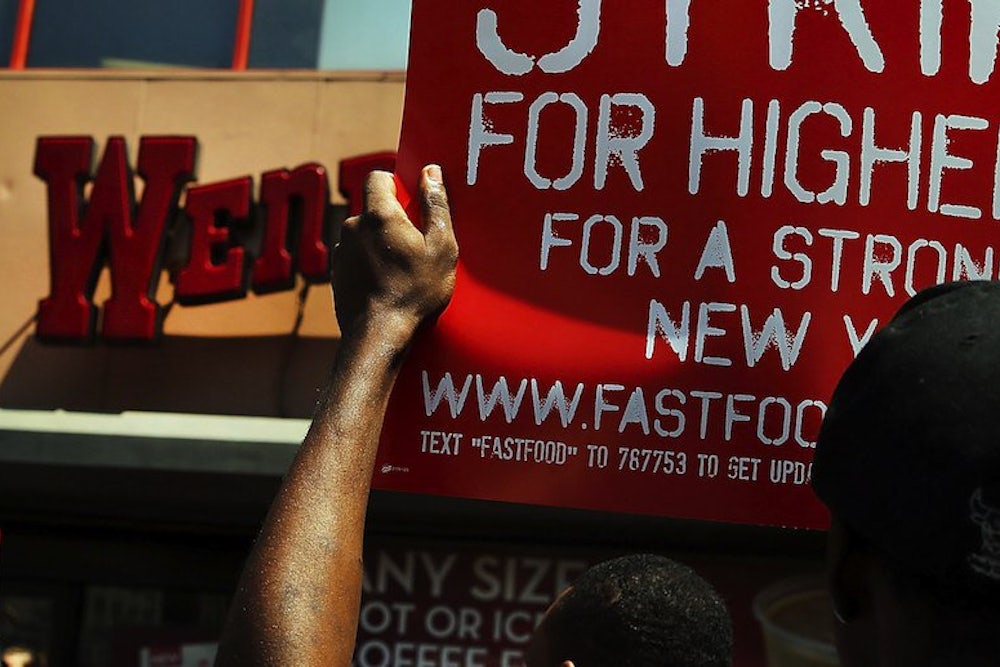There's been a remarkable amount of anti-labor rhetoric in America these past few years, even as low-wage workers now comprise approximately a quarter of all U.S. jobs. But this week has raised hopes of an effective counterattack. Non-unionized fast-food employees have staged one-day strikes across the country to demand a living wage—and have received reams of press for their cause.
These strikes—staged at peak meal times in multiple cities throughout the week, bringing together workers from multiple fast-food chains—are a departure from labor's longtime tactic of collective bargaining. The aim is not so much to disrupt employers' balance sheets in a lasting, meaningful way: Striking workers can number as few as 10, protesting outside while most of their colleagues carry on inside. But the one-day strikes have shined a national spotlight on the low wages paid by companies like McDonald's, Burger King, and Wendy's. (The workers, many of whom make the minimum wage of $7.25/hour, are demanding $15/hour.)
The Service Employees International Union, no doubt hoping to boost its membership, has underwritten the strike campaign with millions of dollars. With the American workplace having shifted away from manufacturing, and labor laws being gutted even in blue states, today’s organizers are left with little but the one-day strike as a tool of fighting back.
“There’s a big disconnect today between the structure of industry and the law,” Nelson Lichtenstein, director of the U.C. Santa Barbara’s Center for the Study of Work, Labor, and Democracy, told me. “The law was designed 70 years ago for vertically integrated manufacturing companies.” Not to mention that old labor laws rely on a sense of permanency that isn’t as prevalent today. “You have 200-300 percent turnover in the fast food industry,” Lichtenstein said. “The law wasn’t designed for that. In this new world, these one-day strikes are one of the kinds of tactics that labor can use.”
It's not an entirely new tactic. The National Labor Relations Act of 1935 codified private-sector employees' right to organize, engage in collective bargaining, and strike—but prior to that, “One-day strikes, or even strikes of a few hours, were very common,” Stephanie Luce, author of Fighting for a Living Wage, said. “If there was a grievance, [workers] might all just stop working and walk off the job.”
The NLRA allowed for the familiar, massive strikes of the twentieth century—at least until the 1990s, when shorter strikes reemerged, in part because of employers' increasing use of replacement workers ("scabs," to some) during general strikes. Now, with the service economy continually expanding and labor laws being further weakened, the one-day strike is likely here to stay. “In general, the one-day strike provides more protection than the traditional, open-ended strike, because the right to strike has basically been gutted,” Joe Burns, author of Reviving the Strike, told me.
The one-day strike is most valuable to workers such as nurses, who know that if they walk off the job—even for a short time—it’s a matter of life and death for hospitals. But to fast-food workers, who occupy the lowest rung of the wage ladder and are considered dispensable, the one-day strike is of limited use. “The value in it comes from the publicity you can generate plus the internal solidarity that you’re able to develop,” Burns says.
Internal solidarity can only go so far in an industry with a 75 percent turnover rate. That's why the one-day strike lives and dies by the media. Front pages and homepages, not picketing workers and hashtags, are striking workers' best means of drawing attention to the issue—of appealing to the millions of Americans who regularly eat fast food, the cost of which is kept low thanks to the workers' pitiful wages.
Of course, the one-day strike could also become a victim of its own success. As the strikes spread across the country, from one city to the next, they may begin to feel like the strikes of old: never-ending, and thus, too easy to ignore.
